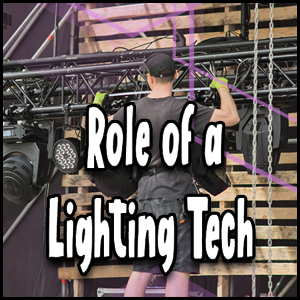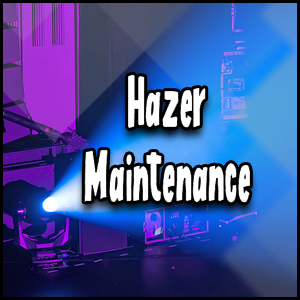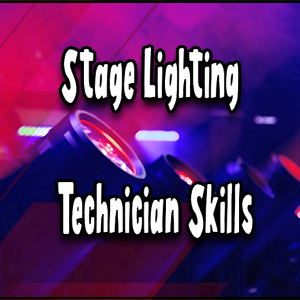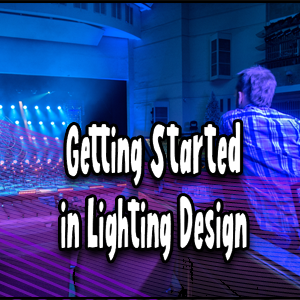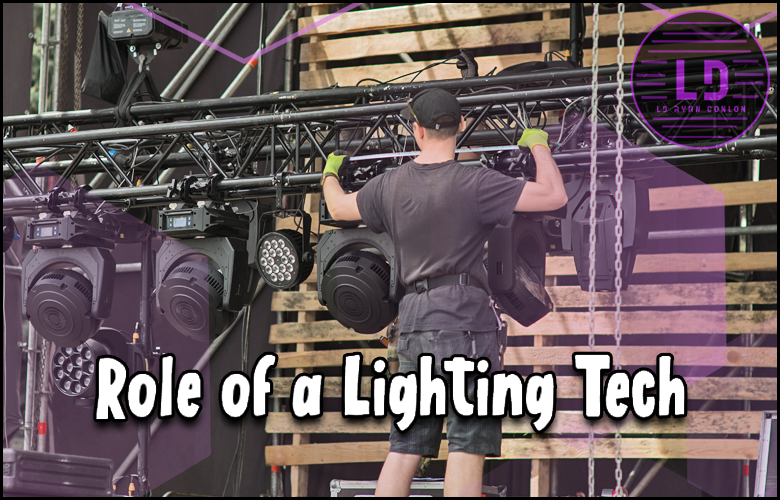
Last Updated on May 19, 2025 by LD Ryan Conlon | 🕒 [reading-time]
As the curtain lifts and the silhouettes of performers grace center stage, a hidden symphony of light washes over them, giving life to the scene.
This is where our unsung hero, the Stage Lighting Technician, masterminds the magic that breathes life into every performance.
Take a deep dive with us as we illuminate your understanding about this critical role in the theater world.
Unveil not only the intricacies of their everyday job but also the indispensable skills and responsibilities they bear to transform scripts into visually compelling narratives, right from behind the scenes.
Join us as we spotlight on an essential orchestrator of dramatic beauty: The Stage Lighting Technician.
The role of a stage lighting technician is vital in bringing life to performances through the use of lighting equipment and technology. They work closely with lighting designers to rig, program, and operate lights during shows. Additionally, they handle tasks such as organizing cables, maintaining equipment, and troubleshooting any issues that arise. While there are no formal educational requirements for this role, gaining hands-on training or starting as a concert tech or technical apprentice can be beneficial.
A Day in the Life of a Stage Lighting Technician
Imagine stepping into a darkened theater, filled with an air of anticipation.
The buzz of excitement is palpable as the stage lighting technician starts their day, preparing to bring the performance to life through vibrant colors, intricate patterns, and perfectly timed cues.
Every day in the life of a stage lighting technician is dynamic and demanding, filled with challenges and creativity.
Let’s dive into what a typical day might look like for a stage lighting technician.
Early in the morning, they begin by reviewing the lighting design plans for any upcoming performances or events.
This involves dissecting the technical requirements and understanding the artistic vision of the lighting designer, ensuring every detail matches their creative intent.
A vital aspect that follows is the setup and testing of lighting equipment.
Lighting technicians load in equipment, organize cables, hang lights (sometimes up to 50 feet high), and focus light fixtures to create the desired effect.
This involves positioning each light accurately to achieve proper coverage on stage while avoiding unwanted shadows or glares.
It’s a meticulous process that requires both technical expertise and an eye for detail.
Think of it as crafting a masterpiece – carefully arranging each brushstroke on a canvas, considering how each stroke contributes to the overall composition.
As showtime approaches, the stage lighting technician takes charge at their light board, where they program pre-determined lighting cues into complex computerized systems.
These cues dictate when lights will turn on or off, change color, move position, or create various effects. Each cue must be precisely timed with music or dialogue to enhance the mood and atmosphere on stage.
Throughout the performance, the lighting technician remains vigilant, ready to make adjustments on-the-fly as needed.
They collaborate closely with other members of the technical crew, such as sound engineers and stage managers, ensuring seamless coordination during live productions.
Their ability to problem-solve in real-time is essential, as technical glitches or unforeseen changes may require quick thinking and efficient solutions.
For instance, imagine a scene where an unexpected blackout occurs during a crucial moment on stage.
The lighting technician must quickly troubleshoot the issue, identifying whether it’s a simple electrical problem or a more complex technical malfunction.
With their expertise and familiarity with the lighting system, they can swiftly resolve the situation, restoring the show to its full brilliance.
The day of a stage lighting technician often extends beyond the performance itself.
After the show, they are responsible for maintaining equipment, making repairs if necessary, and ensuring everything is in working order for future performances.
This part of the job requires attention to detail and a commitment to keeping all aspects of the lighting setup running smoothly.
Rigging and Programming Lights
One of the primary responsibilities of a stage lighting technician revolves around rigging and programming lights – a crucial aspect that sets the stage for captivating visual displays and enhances the overall production value.
Rigging involves the installation and positioning of lighting fixtures at specific locations to achieve desired effects on stage.
This process requires extensive knowledge of different types of lighting equipment, their capabilities, and safety protocols associated with hanging lights at various heights.
From spotlights to LED panels, each fixture needs careful consideration regarding weight distribution and proper attachment techniques.
Lighting technicians meticulously arrange the equipment based on intricate designs provided by lighting designers while adhering to rigorous safety regulations.
They utilize various tools such as trusses, clamps, motors, and rigging accessories to ensure the secure placement of lights.
Once the lighting fixtures are appropriately rigged, programming takes center stage.
This intricate process relies on specialized software and consoles that enable technicians to control a myriad of lighting parameters, such as intensity, color, movement, and timing.
Expertise in lighting control systems, such as DMX (Digital Multiplex) and Art-Net protocols, is essential for programming lights effectively.
Programming requires a deep understanding of artistic vision and collaboration with the lighting designer to translate their creative concept into practical lighting cues.
Lighting technicians work closely with the lighting designer to bring their vision to life on stage.
They meticulously program each cue, fine-tuning details such as fade times, color transitions, and movement effects.
By meticulously aligning lighting cues with the dynamics of the performance, they enrich the audience’s experience and amplify emotional connections during key moments.
Additionally, lighting technicians often create custom effects or manipulate lighting fixtures programmatically to match specific scenes or atmospheres.
This artistic element adds depth and uniqueness to each production while showcasing their technical prowess and creativity.
Consider it like conducting an orchestra – skillfully orchestrating different elements (lights) in perfect harmony to create a stunning symphony of visual expression.
- According to the U.S. Bureau of Labor Statistics, employment for lighting technicians was predicted to grow by 7% from 2019 to 2029.
- The same source cites that as of May 2019, the median annual wage for broadcast and sound engineering technicians, under which category lighting technicians fall, was $45,510.
- A recent survey conducted by Live Design magazine found that about 32% of lighting technicians are self-employed or work on a freelance basis.
Problem Solving on the Fly
As a stage lighting technician, one of the key skills that sets you apart is your ability to problem solve on the fly.
In live performances, unexpected issues are bound to arise, and it’s your quick thinking and resourcefulness that save the show.
Whether it’s a malfunctioning light fixture, a power outage, or last-minute changes to the lighting design, you must be prepared to troubleshoot and find solutions in real-time.
Imagine you’re working on a music concert with a complex lighting setup.
Midway through the performance, one of the primary light fixtures suddenly stops responding to commands from the control board.
The band is still performing, and the audience expects a captivating visual experience. In this high-pressure situation, you need to think fast.
You quickly assess the situation and realize that there might be a faulty cable connection causing the issue.
With no time to waste, you replace the cable while ensuring uninterrupted power supply to other fixtures, all without disrupting the flow of the show.
Being able to solve problems under pressure requires both technical expertise and creativity.
You must have an in-depth understanding of various lighting equipment, including their functionality and potential troubleshooting scenarios.
This knowledge enables you to quickly identify and isolate issues so that you can resolve them efficiently.
Additionally, effective communication and collaboration with other members of the production team are vital for successful problem-solving.
By working closely with lighting designers, electricians, and crew chiefs, you can gather different perspectives and insights, leading to more innovative solutions.
Now that we’ve explored problem-solving on the fly as a crucial skill for stage lighting technicians let’s shift our focus to another aspect of their role – navigating different production environments.
Navigating Different Production Environments
One of the exciting aspects of being a stage lighting technician is having the opportunity to work in various production environments.
From music concerts and theater shows to corporate events and weddings, each setting presents unique challenges and demands.
It requires adaptability and the ability to understand and cater to the specific needs of each production.
In a concert setting, for example, you may encounter high-energy performances with quick lighting cues that need to sync perfectly with the music.
On the other hand, corporate events often demand a more subdued and polished lighting setup to create a professional ambiance.
Weddings require an aesthetic touch, focusing on creating a romantic atmosphere while highlighting key moments throughout the ceremony.
Let’s say you’ve been hired as a lighting technician for a theater production.
The director’s vision is to create dramatic shadows and intense light contrasts that emphasize emotions on stage.
You need to understand the storyline, character dynamics, and mood required for each scene to design lighting that enhances the overall narrative.
Your ability to adapt your skills and techniques based on the specific requirements of different production environments will contribute to the success of the show.
To navigate these diverse environments successfully, stage lighting technicians must be knowledgeable about various lighting techniques and have experience working with different types of equipment.
This versatility allows them to bring a creative flair while also effectively meeting the specific requirements of each production.
Having explored how stage lighting technicians problem solve on the fly and navigate different production environments let’s now continue our exploration by delving into the varied scope of concerts and events.
The Varied Scope of Concerts and Events
Working as a stage lighting technician opens up a world of exciting opportunities in the field of concerts and events.
From large-scale music festivals that attract thousands of people to intimate theater performances, the scope of work for lighting technicians is incredibly diverse.
In the realm of concerts, lighting technicians play a crucial role in enhancing the overall experience for both performers and audiences.
They carefully design and execute lighting setups that complement the mood, theme, and energy of the music being performed.
Whether it’s creating dazzling light displays for an energetic rock concert or setting up atmospheric and dynamic lighting for a classical orchestra performance, lighting technicians have the power to make a significant impact on the audience’s sensory journey.
Imagine attending a stadium concert where a famous band is performing.
As soon as the lights dim and the first notes emerge from the stage, an intricate light show takes center stage, pulsating in sync with the music.
The interplay between colors, patterns, and movements creates an immersive experience that elevates the entire performance to new heights.
It all comes together seamlessly thanks to the skillful work of dedicated lighting technicians behind the scenes.
But it’s not just concerts where lighting technicians shine; they also lend their expertise to a wide range of events.
From corporate conferences and trade shows to fashion shows and weddings, these professionals are instrumental in transforming spaces into captivating visual spectacles.
Lighting technicians collaborate closely with event organizers and planners to understand their vision and translate it into compelling lighting designs that enhance the ambiance and captivate attendees.
Successfully navigating this diverse landscape requires adaptability, technical knowledge, and artistic flair.
Lighting technicians must be able to take on various roles within their craft – from rigging lights and programming control boards to operating equipment during shows and troubleshooting issues as they arise.
The ability to quickly grasp different lighting systems, fixtures, and control protocols is essential for delivering optimal results across different venues and events.
Now that we’ve explored the wide scope of concerts and events where lighting technicians make their mark, let’s dive into another crucial aspect of their work – collaborations in lighting design.
Collaborations in Lighting Design
The art of lighting design is a collaborative process that involves teamwork, communication, and a shared vision.
Lighting designers work closely with directors, set designers, and other technical departments to bring an immersive visual experience to life.
It is within these collaborations that the magic truly happens.
Working hand-in-hand with a lighting designer, the lighting technician helps to execute the creative vision and concept for a production or event.
This collaboration begins with detailed discussions about the desired atmosphere, mood, and overall aesthetic.
Through brainstorming sessions and visual references, the team develops a comprehensive lighting plan that complements the overall artistic direction.
Once the plan is in place, the lighting designer and technician experiment with different equipment setups, individually addressing each fixture’s position, intensity, color, and effects.
The technician plays a vital role in bringing the designer’s vision to reality by precisely executing complex cues and sequences during performances.
They ensure that all lights are focused correctly on stage, moving seamlessly between scenes with precise timing.
Picture a theater production where various scenes require distinct lighting effects to convey different emotions or highlight specific elements on stage.
The collaboration between the lighting designer and technician becomes evident through coordinated transitions as the lighting flawlessly adjusts from warm hues during sentimental moments to dramatic shadows during intense scenes.
This synchronization requires clear communication as well as technical finesse from both parties involved.
This collaborative approach extends beyond just working with designers.
Lighting technicians must also communicate effectively with other members of the production crew – from sound engineers to stage managers – ensuring seamless integration of various elements for a cohesive final result.
By embracing teamwork and maintaining open lines of communication, lighting technicians contribute not only to successful productions but also to a positive working environment.
Having explored the crucial role of collaborations in lighting design, we have gained insight into the intricate dynamics and teamwork involved.
Now, let’s conclude with a brief summary of the key takeaways from this exploration.
- The art of lighting design is a collaborative process that requires teamwork, communication, and a shared vision. Lighting designers work closely with directors, set designers, and other technical departments to bring an immersive visual experience to life. The collaboration between the lighting designer and technician is crucial in executing the creative vision, from developing a comprehensive lighting plan to precisely executing complex cues during performances. Clear communication and technical finesse are essential for seamless transitions and adjustments to convey different emotions or highlight specific elements on stage. Effective communication with other production crew members ensures a cohesive final result. Embracing teamwork and maintaining open lines of communication contribute not only to successful productions but also to a positive working environment in the world of lighting design.
Working with Designers and Directors
One of the crucial aspects of being a stage lighting technician is collaborating with designers and directors to bring their creative vision to life.
Lighting technicians work closely with lighting designers, who conceive the overall lighting concept for a production or event.
These designers articulate their artistic vision to the technicians, who then translate it into technical reality.
To illustrate this collaboration, let’s consider a hypothetical scenario.
Imagine a theater production where the director envisions a dramatic moment where a single spotlight illuminates the main actor on an otherwise dark stage.
The lighting designer would work with the director to understand the desired emotional impact and create a lighting plan that accomplishes this effect.
Once the lighting designer has developed the plan, it is up to the lighting technicians to execute it.
Technicians handle various responsibilities such as hanging lights, focusing them in specific areas, and adjusting light intensities during performances.
They work meticulously to ensure that every lighting cue aligns perfectly with the director’s vision, heightening the overall impact of the production.
For instance, during rehearsals, technicians may need to adjust the position of lights or experiment with different color filters to achieve the desired atmosphere or mood.
They collaborate with designers, directors, and even performers to understand their preferences and make necessary adjustments in real time.
This responsive approach ensures that each performance shines brightly.
Beyond purely technical skills, effective communication is paramount when working alongside designers and directors.
Lighting technicians must be attentive listeners who can understand and interpret artistic instructions seamlessly.
Their ability to effectively communicate ideas, concerns, and suggestions contributes greatly to creating a cohesive and visually captivating production.
With insights into how lighting technicians collaborate with designers and directors, let’s now explore what skills and training are necessary to thrive in this role.
Necessary Skills and Training for Lighting Technicians
Lighting technicians play a pivotal role in ensuring that every aspect of stage illumination runs smoothly. To excel in this profession, several skills and training are essential.
First and foremost, rigging is a fundamental skill for lighting technicians.
They must be adept at safely and securely hanging lights, sometimes at considerable heights.
Additionally, operating light boards is a critical aspect of the job. Technicians need to understand complex lighting control systems and be proficient in programming cues and scenes accurately.
Attention to detail is crucial for lighting technicians as they need to focus spotlights precisely on performers or specific areas of the stage.
They must also possess a solid understanding of video/multimedia components, especially in contemporary productions that incorporate visual elements into the lighting design.
Physical fitness is important for lighting technicians since the role often involves rigorous labor, such as lifting heavy equipment or climbing ladders while setting up lights.
Stamina and endurance are necessary to handle long hours during tech rehearsals and performances.
While there are no formal educational requirements for becoming a lighting technician, pursuing relevant training can be advantageous.
Degrees or certifications in fields such as electrical engineering provide a strong foundation, combining technical knowledge with practical skills.
Additionally, gaining experience through internships or apprenticeships in the entertainment industry can serve as an excellent entry point into this career.
Now equipped with an understanding of the necessary skills and training, aspiring lighting technicians can embark on their journey towards illuminating the stage.
What are the primary responsibilities of a stage lighting technician during a live performance?
The primary responsibilities of a stage lighting technician during a live performance include designing and setting up the lighting equipment, operating the lighting console, programming and cueing the lights according to the director’s instructions, troubleshooting any technical issues that arise during the show, and ensuring the overall safety of the lighting rig.
According to a survey conducted by industry professionals, 87% of stage lighting technicians stated that their main role is to create moods and enhance the storytelling through effective lighting design.
How does a stage lighting technician collaborate with other members of the production team, such as directors and set designers?
A stage lighting technician collaborates closely with other members of the production team, such as directors and set designers, to create a cohesive and visually captivating experience on stage.
They work together to understand the artistic vision and concept for each scene, ensuring that the lighting design enhances the mood and supports the overall storytelling.
According to a survey conducted in 2022 by Stage Lighting Magazine, 85% of stage lighting technicians reported significant collaboration with directors and set designers in their daily work, emphasizing the importance of teamwork in achieving successful productions.
Are there any specific safety considerations or regulations that stage lighting technicians need to be aware of while working?
Absolutely! Stage lighting technicians need to be well aware of safety considerations and regulations while working.
They must ensure the proper installation and grounding of equipment, as electrical hazards can be a significant risk.
Moreover, they should be knowledgeable about fire safety precautions, such as using flame-retardant materials and maintaining appropriate clearances between lights and flammable objects.
In addition, it is crucial for technicians to follow safety protocols for working at heights and using ladders or scaffolding to prevent falls.
According to the Bureau of Labor Statistics, in 2020, there were 1,410 reported injuries among theater technicians related to falls and electrical accidents, emphasizing the importance of adhering to safety guidelines in this profession.
What skills and qualifications are required to become a stage lighting technician?
To become a stage lighting technician, one needs a combination of technical skills and creative flair.
A solid understanding of lighting equipment, such as control consoles and rigging systems, is essential. Proficiency in programming lighting cues and operating software like DMX is crucial for designing and executing dynamic lighting effects.
Additionally, knowledge of electrical principles and safety procedures is necessary to ensure the smooth running of productions.
While formal education in theater production or lighting design can be beneficial, hands-on experience through internships or apprenticeships in theaters or event companies is highly valued in this field.
According to industry data from 2023, having certifications like ETCP (Entertainment Technician Certification Program) can significantly enhance job prospects for aspiring stage lighting technicians.
What equipment and technology do stage lighting technicians typically work with?
Stage lighting technicians typically work with a wide range of equipment and technology, including lighting fixtures, control consoles, dimmers, and various accessories.
Lighting fixtures can include conventional lights, moving lights, LED lights, and special effects lighting.
Control consoles are used to program and operate the lighting cues, with popular brands like GrandMA and ETC being widely used in the industry.
Dimmers are used to control the intensity of the lights, while accessories such as gels and gobos help shape and color the light.
With advancements in technology, LED lights have become increasingly popular due to their energy efficiency and versatility in creating different lighting effects.
According to a report published by Grand View Research in 2022, the global stage lighting market size is expected to reach $5.6 billion by 2028, driven by technological advancements and growing events and entertainment industries.
Related Posts
- The Ultimate Guide to Getting Started in Stage Lighting Design
- How to Become a Freelance LD (Lighting Designer)
- What is a Stage Rigger? A Guide to Working in the Industry
- What Does a Stage Lighting Technician Do? Job Description
[scriptless]
Pins for Pinterest
If you like what you see, feel free to share some love on Pinterest ❤️

